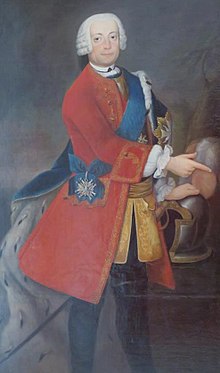Karl of Mecklenburg (1708–1752)
Karl, Duke of Mecklenburg [-Strelitz], called "Prince von Mirow" (born February 23, 1708 in Strelitz , † June 4, 1752 in Mirow ), was a prince of the House of Mecklenburg-Strelitz . Two of his sons, Adolf Friedrich (IV.) And Karl (II.), Later became regents of Mecklenburg in the Mecklenburg-Strelitz region, and one daughter became Queen of Great Britain.
Life
Karl (Ludwig Friedrich) was apanaged with Mirow as the youngest son of Duke Adolf Friedrich II, who had ruled Mecklenburg-Strelitz since 1701 . There he lived with his family first on the castle island , later in the so-called lower or new castle.
After the father's death, the succession to the throne fell in Mecklenburg-Strelitz Karl's older half-brother Adolf Friedrich III. to. After it was foreseeable that no male heirs would emerge from his marriage, the political importance of the Mirow branch, which in all probability would represent the future heir to the throne , grew according to the principle of the second generation. Whether in 1738 the choice of a name by Karl's first-born son Adolf Friedrich (IV.) Was subject to this stipulation has not (so far) been proven. It is noteworthy that five of the nine ruling princes in Mecklenburg-Strelitz bore the name Adolf Friedrich, which means that when this name was given, a house tradition had developed. The political trial of strength in Mecklenburg between the ruling dukes and the knighthood, who saw Karl as their ally, in the run-up to and during the negotiations on the constitutional settlement of inheritance concluded in 1755, increasingly strained the relationship between the two half-brothers.
From the middle of the 1730s, Karl gathered a large number of young aristocrats and academics in Mirow, who in the second half of the century belonged to the intellectual elite of the small south-east Mecklenburg region. He maintained contacts with the later King of Prussia, Friedrich (II.) In Rheinsberg as well as with Hanover and lived in the pietistic piety typical of the time, which was more moderate. At Karl's urging, the early work of Samuel Buchholz , one of the great Brandenburg historiographers of the late Enlightenment, was created.
When Karl died in 1752 at the age of 44, his first-born became the Hereditary Prince of Mecklenburg-Strelitz and - as Karl's brother died six months after him without male descendants - under considerable political turbulence as Adolf Friedrich IV. Ruling prince of the Strelitz part of the country.
Marriage and offspring
On February 5, 1735, Duke Karl married Princess Elisabeth Albertine in Eisfeld , daughter of Duke Ernst Friedrich I of Saxony-Hildburghausen , who - appointed by the Emperor as guardian of her children - later temporarily reigned for her older son in Mecklenburg-Strelitz. In the guardianship dispute of 1752/53, in which Duke Christian Ludwig II of Mecklenburg-Schwerin, as the closest male relative, claimed guardianship at least for the eldest son, she played a central role.
This marriage resulted in ten children, six of whom reached adulthood:
- Christiane (1735–1794)
- Caroline (* / † 1736)
- Adolf Friedrich IV. (1738–1794), (ruling) Duke of Mecklenburg [-Strelitz]
- Elisabeth Christine (1739–1740)
- Sophie Louise (1740–1741)
- Karl II. (1741-1816), (ruling) Duke of, later Grand Duke of Mecklenburg [-Strelitz]
- Ernst (1742-1814)
- Sophie Charlotte (1744–1818) ⚭ 1761 King George III. of Great Britain
- Gotthilf (* / † 1745)
- Georg (August) (1748–1785), Imperial Major General in Hungary
literature
- Ludwig Giesebrecht: The Fürstenhof in Mirow during the years 1708–1761. Szczecin, 1863.
- Helmut Borth: Castles on the Path (2004)
- Frank Erstling: Mecklenburg-Strelitz, Contributions to the History of a Region (2002)
Individual evidence
- ↑ NOT: Karl I or Carl I , as it is often wrongly called. Since Duke Karl never came to the government, he logically does not appear in the dynastic count of the Mecklenburg Princely House. The count of his son as Karl II follows Karl I (1540-1610), ruling Duke of Mecklenburg in the Mecklenburg-Güstrow region
Web links
| personal data | |
|---|---|
| SURNAME | Karl of Mecklenburg |
| ALTERNATIVE NAMES | Carl; Carl Ludwig Friedrich; Karl Ludwig Friedrich |
| BRIEF DESCRIPTION | Prince, adH Mecklenburg-Strelitz; Duke of Mecklenburg; called Prince von Mirow |
| DATE OF BIRTH | February 23, 1708 |
| PLACE OF BIRTH | Strelitz |
| DATE OF DEATH | June 4, 1752 |
| Place of death | Mirow |


